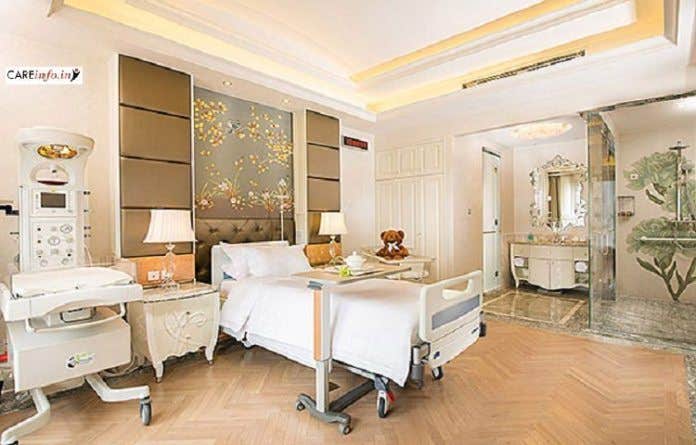Hospital room features can affect your recovery after surgery
Study shows single room occupancy, distance to nurse’s station, and window view may affect clinical outcomes following high-risk operations.

[Oct 18, 2022: Sally Garneski, American College of Surgeons]
Certain hospital room features, such as having a window view and distance from a nursing station, may influence clinical outcomes. (CREDIT: Creative Commons)
University of Michigan study shows single room occupancy, distance to nurse’s station, and window view may affect clinical outcomes following high-risk operations.
Certain hospital room features, such as having a window view and distance from a nursing station, may influence clinical outcomes after undergoing high-risk operations, according to research findings presented at the Scientific Forum of the American College of Surgeons (ACS) Clinical Congress 2022.
Each year, about $50 billion is spent on the construction of health care facilities in the United States. Architecture and interior design can enhance patient care and outcomes. A seminal comparative study published in Science in 1984 revealed that having a window view may influence recovery from surgery, and additional research has found that severely ill patients who are assigned to ICU rooms that are not well visualized by the medical staff may experience worse outcomes.
However, little research has investigated how room features such as single versus double occupancy, distance from a nursing station, and a window view may impact clinical outcomes. Researchers at the University of Michigan sought to understand whether certain hospital room features impact mortality and length of stay after surgery.
Related Stories
“We were fascinated to see from a previous study that mortality was different in rooms that were in the line of sight of a nurse’s station. Nurses could more readily assess the patient’s condition and intervene more quickly in severe events. We wanted to see how this finding would play out at our institution, specifically in a surgical population,” said study coauthor Mitchell J. Mead, a health and design scholar at the University of Michigan.
“One of the next big steps for health care design is to understand these pathways of causation that can lead to different clinical outcomes in patients staying in hospital rooms with different features.”
The analysis for this single-site study involved 3,964 patients who underwent 13 high-risk surgical procedures (including colectomy, pancreatectomy, and kidney transplant) at the University of Michigan Hospital between 2016 and 2019. The patients were admitted to rooms on two hospital floors.
Patient rooms were coded based on their features—window or no window, single occupancy, double occupancy, distance to the nursing station, and line of sight to clinicians. Patient encounters were linked by room number to identify clinical outcomes, including mortality and length of stay, related to room design.
Key findings
Mortality rates for high-risk procedures varied across room design features and room type.
Room features that influenced clinical outcomes after surgery included distance from a nursing station, single room occupancy, and having a direct line of sight where clinicians can see into the room.
After adjusting for patient comorbidities and complexity of the operation, mortality rates were 20% higher (odds ratio 1.2) if patients were admitted to a hospital room without a window than if they were put in a room with a window.
For patients staying in a room without a window, 30-day mortality rates were 10% higher (odds ratio 1.1).
Though mortality rates varied across room design, mortality rates did not vary by room type after accounting for length of stay, suggesting that length of stay does not account for differences in mortality.
“This investigation provided evidence that patients had differential outcomes across room design features, when accounting for clinical risk, and warrants further investigation for how hospital design may be influencing outcomes,” Mr. Mead said.
When the authors looked at different rooms based on the favorable design features, it became clear that the sicker patients were more likely to get single rooms, closer to a nursing station and within direct line of sight, and a window view, added study coauthor Andrew M. Ibrahim, MD, MSc, assistant professor of surgery, architecture, and urban planning at the University of Michigan and co-director of the Center for Outcomes and Policy.
Dr. Ibrahim noted that this study is just one example illustrating the often-overlooked relationship between hospital design and patient care. Investing in research to figure out what design features work best may be one key factor in improving patient outcomes. “I think we can get a much better return on what we build and hopefully design safer, healthier hospitals,” he said.
Future studies should investigate these outcomes at multiple hospitals to find out if the results are generalizable, the authors suggest. They are in the process of replicating a similar study across Michigan Medicine and hope to recruit collaborators across other hospital systems.
In addition, the researchers hope to expand their study to include other metrics like use of pain medication and patient satisfaction across these room types.
“The common question we get asked is, do you want us to rebuild our hospitals? Of course, that is not practical. But we do recognize clear patterns where certain room types have better outcomes after surgery,” Dr. Ibrahim said. “We can start to prioritize the sickest patients there. Just the way we have developed precision health models for getting the right care to the patient, there may be a corollary for the right room for the right patient and procedure to optimize outcomes collectively.”
Key Takeaways
- Billions of dollars are invested in the design and construction of health care facilities each year, but few studies have evaluated the impact of hospital room design.
- Single-site study at the University of Michigan evaluated whether certain hospital room features impact mortality and length of stay after surgery.
- Researchers found that hospital room features such as distance from a nursing station, staying in a single room, and having a direct line of sight to clinicians may influence clinical outcomes post-surgery. These findings highlight the need for more research on hospital room design.
The study was funded by the department of surgery at the University of Michigan.
Citation: Mead MJ, et al. Evaluating Mortality and Hospital Room Design after High-Risk Inpatient Surgery, Scientific Forum, American College of Surgeons Clinical Congress 2022.
Note: Materials provided above by American College of Surgeons. Content may be edited for style and length.
Like these kind of feel good stories? Get the Brighter Side of News' newsletter.
Joseph Shavit
Head Science News Writer | Communicating Innovation & Discovery
Based in Los Angeles, Joseph Shavit is an accomplished science journalist, head science news writer and co-founder at The Brighter Side of News, where he translates cutting-edge discoveries into compelling stories for a broad audience. With a strong background spanning science, business, product management, media leadership, and entrepreneurship, Joseph brings a unique perspective to science communication. His expertise allows him to uncover the intersection of technological advancements and market potential, shedding light on how groundbreaking research evolves into transformative products and industries.



